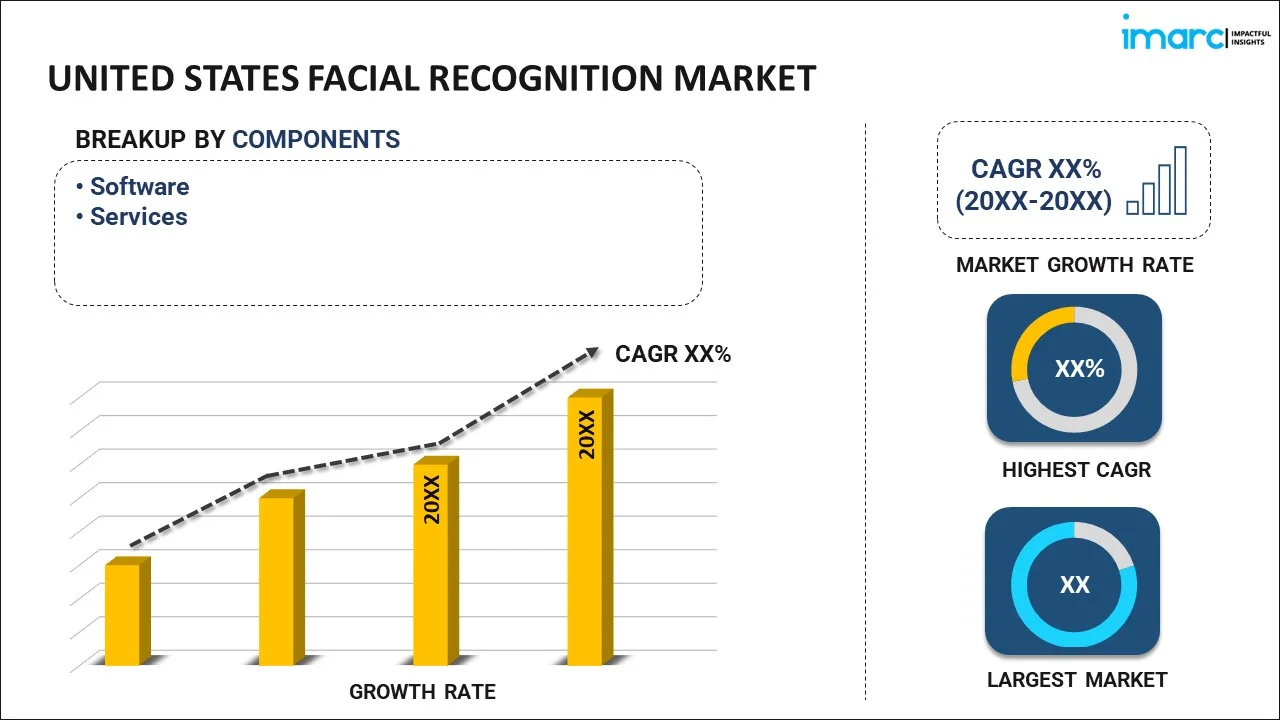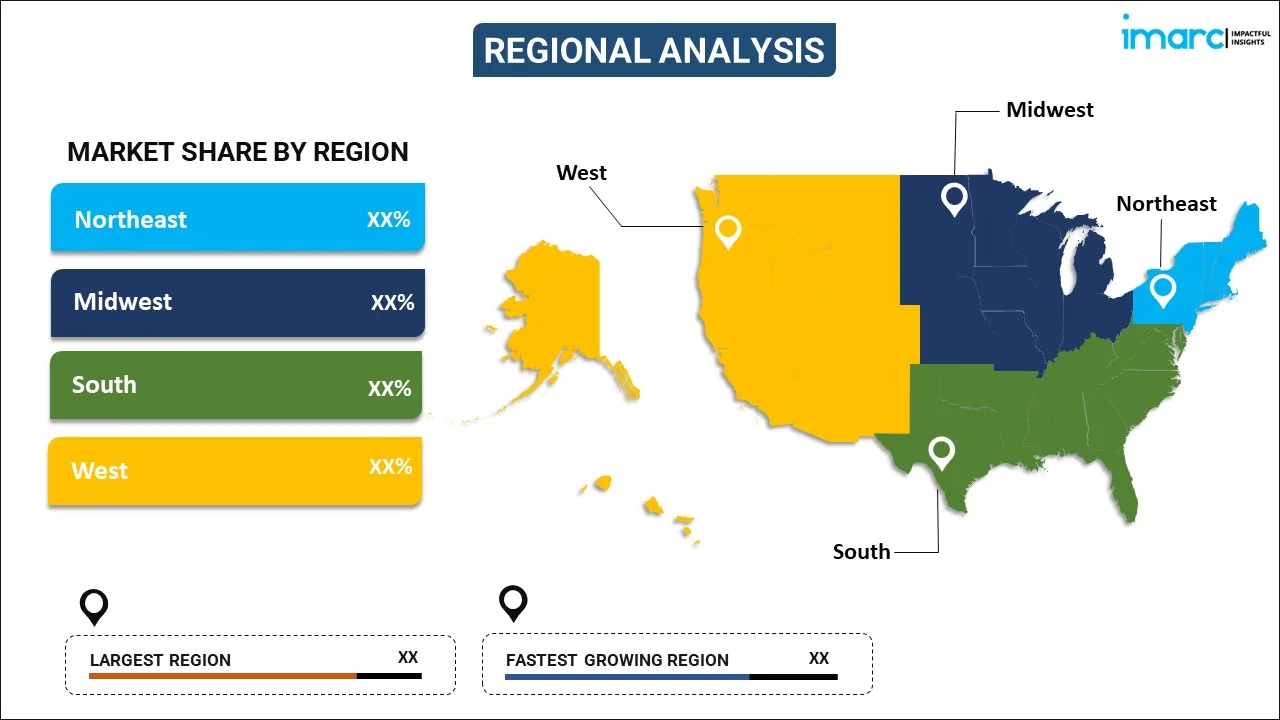
United States Facial Recognition Market Report by Component (Software, Services), Technology (2D Facial Recognition, 3D Facial Recognition, Facial Analytics), Application (Emotion Recognition, Attendance Tracking and Monitoring, Access Control, Security and Surveillance, and Others), End Use Industry (Retail and E-commerce, BFSI, Government and Defense, Automotive and Transportation, Media and Entertainment, Healthcare, Telecom and IT, and Others), and Region 2024-2032
Market Overview:
United States facial recognition market size is projected to exhibit a growth rate (CAGR) of 14.50% during 2024-2032. The growing utilization of enhanced security solutions for identity verification during online transactions, reducing fraud, and improving online security, rising focus on hygiene and contactless interactions, and increasing need to enhance public safety represent some of the key factors driving the market.
|
Report Attribute
|
Key Statistics
|
|---|---|
|
Base Year
|
2023 |
|
Forecast Years
|
2024-2032
|
|
Historical Years
|
2018-2023
|
| Market Growth Rate (2024-2032) | 14.50% |
Facial recognition is an advanced technology that is used to identify and verify individuals by analyzing unique facial features. It works by capturing and analyzing various facial characteristics, such as the shape of the face, eyes, nose, and mouth, and even specific details like facial landmarks and skin texture. It can help identify suspects captured on surveillance cameras and locate missing persons. It plays a crucial role in places that require precise identification of individuals. It offers a quick and accurate means of authentication, significantly enhancing security and convenience. It allows organizations to personalize marketing efforts and streamline payment processes. It assists in reducing the risk of unauthorized access to secure areas or devices. Besides this, it aids in streamlining verification processes and saves time. As it is beneficial in preventing identity theft and fraud, the demand for facial recognition is rising in the United States.
United States Facial Recognition Market Trends:
The escalating demand for facial recognition in smartphones and tablets to allow users to unlock their devices, access apps, and make secure transactions represents one of the major factors influencing the market positively in the United States. Additionally, the increasing employment of facial recognition in healthcare settings, as it helps with patient identification and access control and improves the efficiency and security of healthcare services, is impelling the growth of the market in the country. Apart from this, there is a rise in the need for facial recognition to enhance public safety. This, coupled with the growing utilization of facial recognition in access control systems to grant or deny entry to secure areas, is offering a positive market outlook in the country. Moreover, the increasing application of facial recognition in e-commerce platforms for identity verification during online transactions, reducing fraud, and improving online security is bolstering the growth of the market. In line with this, advancements in artificial intelligence (AI) and machine learning (ML) algorithms are improving the accuracy and performance of facial recognition systems, which is strengthening the market growth in the US. Furthermore, the rising focus on hygiene and contactless interactions among the masses is providing lucrative growth opportunities to industry investors. In addition, the integration of facial recognition with other biometric technologies, such as fingerprint scanning and iris recognition, to enhance overall security measures is contributing to the market growth in the country. The increasing adoption of facial recognition in organizations to comply with industry-specific regulations and security standards is propelling the market growth.
United States Facial Recognition Market Segmentation:
IMARC Group provides an analysis of the key trends in each segment of the market, along with forecasts at the country level for 2024-2032. Our report has categorized the market based on component, technology, application, and end use industry.
Component Insights:

- Software
- Services
The report has provided a detailed breakup and analysis of the market based on the component. This includes software and services.
Technology Insights:
- 2D Facial Recognition
- 3D Facial Recognition
- Facial Analytics
A detailed breakup and analysis of the market based on the technology have also been provided in the report. This includes 2d facial recognition, 3d facial recognition, and facial analytics.
Application Insights:
- Emotion Recognition
- Attendance Tracking and Monitoring
- Access Control
- Security and Surveillance
- Others
The report has provided a detailed breakup and analysis of the market based on the application. This includes emotion recognition, attendance tracking and monitoring, access control, security and surveillance, and others.
End Use Industry Insights:
- Retail and E-commerce
- BFSI
- Government and Defense
- Automotive and Transportation
- Media and Entertainment
- Healthcare
- Telecom and IT
- Others
A detailed breakup and analysis of the market based on the end use industry have also been provided in the report. This includes retail and e-commerce, BFSI, government and defense, automotive and transportation, media and entertainment, healthcare, telecom and IT, and others.
Regional Insights:

- Northeast
- Midwest
- South
- West
The report has also provided a comprehensive analysis of all the major regional markets, which include Northeast, Midwest, South, and West.
Competitive Landscape:
The market research report has also provided a comprehensive analysis of the competitive landscape. Competitive analysis such as market structure, key player positioning, top winning strategies, competitive dashboard, and company evaluation quadrant has been covered in the report. Also, detailed profiles of all major companies have been provided.
United States Facial Recognition Market Report Coverage:
| Report Features | Details |
|---|---|
| Base Year of the Analysis | 2023 |
| Historical Period | 2018-2023 |
| Forecast Period | 2024-2032 |
| Units | US$ Million |
| Scope of the Report | Exploration of Historical and Forecast Trends, Industry Catalysts and Challenges, Segment-Wise Historical and Predictive Market Assessment:
|
| Components Covered | Software, Services |
| Technologies Covered | 2D Facial Recognition, 3D Facial Recognition, Facial Analytics |
| Applications Covered | Emotion Recognition, Attendance Tracking and Monitoring, Access Control, Security and Surveillance, Others |
| End Use Industries Covered | Retail and E-commerce, BFSI, Government and Defense, Automotive and Transportation, Media and Entertainment, Healthcare, Telecom and IT, Others |
| Regions Covered | Northeast, Midwest, South, West |
| Customization Scope | 10% Free Customization |
| Report Price and Purchase Option | Single User License: US$ 3699 Five User License: US$ 4699 Corporate License: US$ 5699 |
| Post-Sale Analyst Support | 10-12 Weeks |
| Delivery Format | PDF and Excel through Email (We can also provide the editable version of the report in PPT/Word format on special request) |
Key Questions Answered in This Report:
- How has the United States facial recognition market performed so far and how will it perform in the coming years?
- What has been the impact of COVID-19 on the United States facial recognition market?
- What is the breakup of the United States facial recognition market on the basis of component?
- What is the breakup of the United States facial recognition market on the basis of technology?
- What is the breakup of the United States facial recognition market on the basis of application?
- What is the breakup of the United States facial recognition market on the basis of end use industry?
- What are the various stages in the value chain of the United States facial recognition market?
- What are the key driving factors and challenges in the United States facial recognition?
- What is the structure of the United States facial recognition market and who are the key players?
- What is the degree of competition in the United States facial recognition market?
Key Benefits for Stakeholders:
- IMARC’s industry report offers a comprehensive quantitative analysis of various market segments, historical and current market trends, market forecasts, and dynamics of the United States facial recognition market from 2018-2032.
- The research report provides the latest information on the market drivers, challenges, and opportunities in the United States facial recognition market.
- Porter's five forces analysis assist stakeholders in assessing the impact of new entrants, competitive rivalry, supplier power, buyer power, and the threat of substitution. It helps stakeholders to analyze the level of competition within the United States facial recognition industry and its attractiveness.
- Competitive landscape allows stakeholders to understand their competitive environment and provides an insight into the current positions of key players in the market.
Need more help?
- Speak to our experienced analysts for insights on the current market scenarios.
- Include additional segments and countries to customize the report as per your requirement.
- Gain an unparalleled competitive advantage in your domain by understanding how to utilize the report and positively impacting your operations and revenue.
- For further assistance, please connect with our analysts.
 Inquire Before Buying
Inquire Before Buying
 Speak to an Analyst
Speak to an Analyst
 Request Brochure
Request Brochure
 Request Customization
Request Customization




.webp)




.webp)












